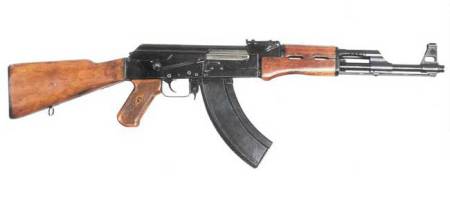The Most Dangerous Weapon of Mass Destruction
Posted on August 15, 2007
…turned 60 this year. And no, it’s not the atomic bomb.
It’s the AK-47 assault rifle — a weapon that was born from the cauldron of World War II, and has since become the emblem of several generations of armed struggle around the world. And in the process, it has taken a startling number of lives.
The idea of the “assault rifle” — a weapon designed to unleash a storm of medium-caliber bullets upon targets at short range — didn’t originate with the Soviet Union. The first army to field them in any quantity was the army of Nazi Germany, which began equipping its troops with the Sturmgewehr 44 in the waning months of World War II. Russian troops, who had no comparable weapon, were unpleasantly surprised by the sudden increase in firepower available to their German opponents, and began to wonder how to match it.
One of those soldiers was Mikhail Kalashnikov, who began contemplating a Soviet assault rifle while recuperating from a battle wound. From his bed, Kalashnikov dreamed of the simplest automatic weapon possible — a weapon so simple that it would withstand even the harshest conditions. When the Soviet government put out a call for design proposals for such a weapon, Kalashnikov responded with the design that would become world famous — the AK-47.
The AK-47 became standard Soviet Army issue in 1949, but its real fame came later, when the Soviets began exporting the weapon to their allies around the world. Frequently, these allies were armies associated with “wars of national liberation” — armies attempting to overthrow the established governments of their countries and replace them with Communist states.
The AK-47 was uniquely well-suited for these armies, because of its simplicity. It had been designed, after all, for use on the World War II Eastern Front — a famously unforgiving environment where ruggedness was prized above all other factors in a weapon. Weapons that jammed easily, that required special care and attention, didn’t last long on the Eastern Front, where temperatures would drop to unbelievable lows and where the front lines were manned by barely-trained peasants. Years of bitter fighting with the Germans in this environment had taught the Russians the value of simplicity and reliability.
The AK-47 became perhaps the single purest distillation of these lessons. It was built to be made cheaply, to require no training to operate, and to be usable even in the worst conditions — in bitter cold or howling sandstorm. To armies of guerrillas around the world, operating in jungles and deserts, leading troops with no training, these qualities made the weapon enormously attractive. (As did the USSR’s willingness to supply them generously to her allies, of course.)
American soldiers ran up against the AK-47 in Vietnam, and found their own weapon — the M-16 — wanting in comparison. In his book Steel My Soldiers’ Hearts, Colonel David Hackworth recalled how a discovery while digging up the earth of Vietnam gave him a chance to demonstrate just how superior the AK-47 was:
One of the bulldozers uncovered the decomposing body of an enemy soldier, complete with AK47. I happened to be standing right there, looking down into the hole and pulled the AK out of the bog.
“Watch this, guys,” I said, “and I’ll show you how a real infantry weapon works.”
I pulled the bolt back and fired 30 rounds – the AK could have been cleaned that day rather than buried in glug for a year or so. That was the kind of weapon our soldiers needed, not the confidence-sapping M-16.
The AK-47 became such a symbol of the guerrilla that when Mozambique won its independence, they put the weapon on their flag. Today in Iraq, American soldiers face insurgents with AK-47s once again.
In the sixty years since Kalashnikov’s first design, the AK-47 has become one of the most widely distributed weapons in the world, for two main reasons. First, the Soviets’ unwillingness to recognize intellectual property made it a kind of “open source” rifle — able to be ripped off by any country that wanted to start producing their own assault rifles. And second, when the Soviet Union collapsed, a tidal wave of AK-47s that had been stored in Soviet armories was unleashed upon the world by cagey Russians out to make a buck.
Estimates are that more than 50 million AK-47s have been produced over the years. Nobody knows how many people have been killed by them, but consider this:
The atomic bombings of Hiroshima and Nagasaki in 1945 — widely considered the worst violence ever unleashed by man — killed about 100,000 people.
Every year, 300,000 to 500,000 people are killed by small arms in brushfire conflicts around the world; and in those conflicts, the most common weapon is the same as it was in 1950, 1970 and 1990 — the AK-47.
That’s mass destruction too. Just in slow motion.
UPDATE (July 24, 2012): If you want a more in-depth treatment of the history of the Kalashnikov family of weapons, I highly recommend C.J. Chivers’ excellent book The Gun, which explores both the history of the family of weapons spawned by the AK-47 and the shameful shortcomings of the development process that led to the M-16.









